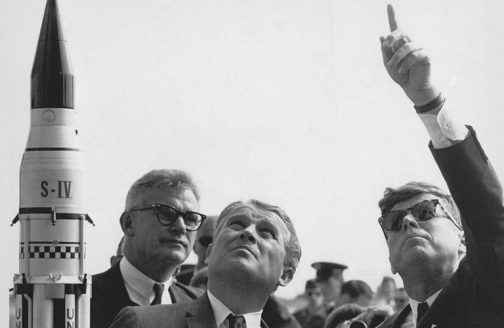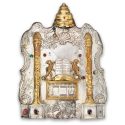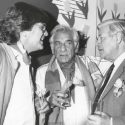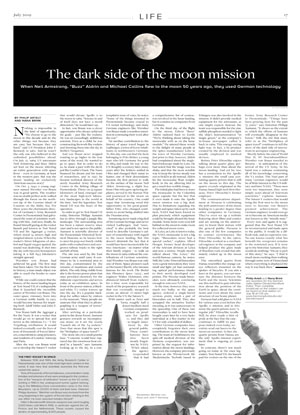When Neil Armstrong, “Buzz” Aldrin and Michael Collins flew to the moon 50 years ago, they used German technology

Nothing is impossible in the land of opportunity. “We choose to go to the moon in this decade and do the other things, not because they are easy, but because they are hard,” said US President John F. Kennedy in 1962. And he wasn’t the only one who believed in the unlimited possibilities ahead. On July 21, 1969, US astronauts Neil Armstrong and Buzz Aldrin set foot on the moon, infecting an entire generation with space fever – even in Germany, at least in the western part. But was the moon landing an exclusively American success story?
On Oct. 3, 1942, a young engineer named Wernher von Braun was in good spirits. The weather was no doubt perfect as he walked through the forest on the northern tip of the German island of Usedom on the Baltic Sea. For three years, the charismatic director of Germany’s Army Research Center in Peenemünde had galvanized the team of scientists working with him. And now, finally, he found himself gazing at the rocket launch pad known as Test Stand VII and his Aggregat 4 rocket, which stood 14 meters high and weighed almost 13 tons. When the rocket’s 8,600 kilograms of alcohol and liquid oxygen ignited, the sound was deafening. It shot into the sky with 650,000 horsepower, taking it a full 84.5 kilometers straight upward.
Wernher von Braun had achieved his goal. The first step had been taken. For the first time in history, a man-made object was able to reach the border to outer space.
While one could contest that the history of the moon landing began at Test Stand VII, it’s indisputable that it launched the incredible career of Wernher von Braun. The outer-space visionary, born into a German noble family in 1912, would become famous for inspiring both Adolf Hitler and John F. Kennedy.
Von Braun built the Aggregat 4 for the Nazis. It was a rocket that would go on to spread fear and terror as the infamous V2 – V for Vergeltung, retribution. It would indeed eventually cost the lives of tens of thousands of forced laborers, concentration camp prisoners, and residents of London, Antwerp and Paris.
After the war, von Braun went on to develop the Saturn V rocket that would elevate Apollo 11 to the moon in 1969. “Science in and of itself does not have a moral dimension,” he would later say.
In fact, von Braun was a clever opportunist who always achieved his goals – just like his rockets. He was an exceedingly ambitious scientist. Even as a child, he was constructing firework-like rockets and shooting them into the sky in Berlin’s Tiergarten.
And von Braun never stopped wanting to go higher in the true sense of the word. He wanted to go to space. But in order to do so, he made a pact with the devil, just like Goethe’s Faust. The Nazis financed his dream and his team of researchers, and in 1937, he became technical director of the newly founded Army Research Center in the fishing village of Peenemünde. There, on 25 square kilometers of land, emerged one of the most high-tech laboratory landscapes in the world at the time. And the legendary Test Stand VII was the heart of the operation.
In order to get to Test Stand VII today, historian Philipp Aumann has to drive through a jungle-like landscape. The surrounding area has been a nature reserve since 1990 and is not open to the public. Aumann is scientific director of the Peenemünde Historical Technical Museum, so he knows how to steer his jeep over barely visible paths with crushed trees and overgrown railway tracks to the right and left of him.
The site was used by the East German army until 1990. It continues to be a restricted area to this day, contaminated by the remains of munitions and rocket debris. The only thing visible from afar is the former power plant that once provided electricity for the elaborate experiments and serves today as an exhibition space. In front of the power station, a blackand- white V2 rocket towers up into the sky. It’s a popular backdrop for selfies taken by visitors to the museum. “Many people are unaware that what they’re photographing is a weapon of terror,” says Aumann.
After arriving at a particular point in the dense forest, Aumann gestures towards an inconspicuous stone; on it are the words “Launch site of the A4 rockets.” Does that mean that this spot is the “birthplace of space travel”?
The stone sits on a small granite base. “Concrete would have ruptured due the enormous heat created by a launch,” says Aumann, looking up to the sky. In a contemplative tone of voice, he notes: “Some of the things invented in Peenemünde became crucial to US rocket technology, and many German engineers like Wernher von Braun made a seamless transition in continuing their work after the war.”
Yet another contribution to the history of space travel began in Ladbergen, a town of 6,000 inhabitants in northwestern Germany. To this day, one can find the farm belonging to Fritz Kötter, a young man who left Germany for good in 1864 and made his way to the US. Roughly a century later, many years after the Kötters settled in Ohio and changed their name to Katter, one of their descendants became the first person to walk on the surface of the moon: Neil Alden Armstrong, a slight boy from Ohio who grew up loving airplanes, served in the Korean War and journeyed to the moon on behalf of his country. One could argue that Armstrong owed this opportunity to his great-grandfather Fritz, who changed continents to avoid being drafted into the Prussian army.
Armstrong never made a big deal of his German heritage and never visited Ladbergen. And “unexcited” is also probably the best word to describe Germany’s culture of remembrance with regard to the moon landing. But this doesn’t diminish the fact that it would have been inconceivable for two Americans – no matter what their family origins – to walk on the moon in 1969 without the contributions of German scientists. And Wernher von Braun was only one of them. Space pioneers such as Hermann Oberth, who became famous for his work The Rocket into Planetary Space (1923), and engineer Walter Hohmann, who distanced himself from rocketry for a time, were responsible for much of the preparatory research that was eventually merged to create an almost 111-meter-high rocket in the US: the Saturn V.
With names such as Zeiss and Varta, roughly half a dozen medium-sized German companies worked on products for Apollo 11; and they did so largely unnoticed by the general public. These contributions have also been mostly forgotten by NASA. When asked, the agency responded that it had a comprehensive list of contractors involved in the lunar landing, but it contains no companies from Germany.
On the third day of the flight to the moon, Edwin “Buzz“ Aldrin radioed back to Earth: “We’re thinking about taking the monocular with us on the lunar module.” He uttered these words to the delight of many people at the optics manufacturer Leitz in the town of Wetzlar, Germany. Just prior to that, however, Aldrin had complained about the single-barrel telescope made by Leitz. He had noted that the image was too shaky, and that the most sensible way to keep the device steady was not to hold it at all; instead, Aldrin let the monocular float weightlessly in the air, allowing him to get a much less wobbly image.
The initial plan had been to leave the monocular in the Columbia space capsule, but the fact that it even made it onto the Apollo moon mission was a big deal. Due to limitations regarding the weight and space taken up by each item, NASA had been forced to plan precisely which equipment could be brought aboard the lunar module. Some items were even left behind on the moon to make room for collected moon rocks.
At Leica, as Leitz is known today, the NASA monocular is not a big topic. “Binoculars never had a special cachet,” explains Alfred Hengst, former head developer of the relevant division at Leica and now a retiree. People mostly talked about “the Leica,” the world-famous camera, he notes. Still, the Leitz Trinovid binoculars were a great innovation; they were small and light yet had outstanding optical performance thanks to their newly developed roof prisms. The Wetzlar-made binoculars were ultimately convincing enough to win over NASA.
At the time, however, they were much too bulky, so the space agency ordered a single-barrel version, pretty much a pair of binoculars cut in half. They also scrapped the attractive leather encasing, as it was unnecessary in the spaceship. One of these rare monoculars is said to have been bought years later by a very lucky individual at a flea market in the US for only a handful of dollars.
Other German companies have completely forgotten their own contributions to the moon landing. The team at Healthineers, the spin-off medical division of the Siemens corporation, was surprised by the request for information about the moon landings. However, the company previously known as the Wernerwerk für Medizinische Technik based in Erlangen was also involved in the mission. It didn’t provide medical equipment for the astronauts, as one might expect; instead, the team was responsible for the zinc sulfide phosphors needed to light the ship’s instrumentation “in magic green,” as the company’s in-house newspaper called it back in 1969. This energy-saving light was, in fact, a by-product created by the division and was usually employed in medical devices.
Retiree Peter Hitzschke enjoys talking about quartz glass, perhaps even more than about the moon landing. And yet he, too, has a connection to the Apollo 11 mission: the small case containing quartz prisms that is still on the moon to this day. The quartz crystals originated at the Hanau-based high-tech firm Heraeus, Peter Hitzschke’s former employer.
The communications department at Heraeus is celebrating the 50th anniversary of the moon landing to a greater degree than other companies in Germany. They’ve even set up a website featuring short films and comics and are seizing on the anniversary to boost their stature with the general public. Heraeus is also one of the few companies to contact eyewitnesses like Peter Hitzschke. In the 1960s, Hitzschke worked as a mechanical engineer at the company and helped produce the glass made of Brazilian rock crystal that ultimately ended up in the moon case.
The smoothed quartz from Hanau resembles the orange cat-eye reflectors mounted on the spokes of bicycles. If you aim a laser at the quartz, you can measure the distance between the Earth and the moon. Scientists use this method to gain information about the position of the Earth in space, about the continents and even about the inner structure of our home planet.
Heraeus had sold glass to NASA for various uses even before the Apollo 11 mission, and in this sense the quartz prisms were “a regular job,” Hitzschke recalls. Still, he does exude a hint of pride at the fact that the case continues to fulfill its purpose; indeed, even today, scientists send out lasers to the moon on occasion. In fact, the quartz prisms from Hanau are the only Apollo mission experiment that is ongoing 50 years later.
In contrast, there’s not much going on today at the once legendary Test Stand VII, the launch pad for rockets on the site of the former Army Research Center in Peenemünde: “Things have been growing here for the past 75 years,” says historian Philipp Aumann. “It shows us the extent to which the efforts of humans will eventually disappear in the forest.” Still, the site that many refer to as the “birthplace of space travel” continues to tell the story of the dark side of innovations in aerospace engineering.
Shortly before the end of World War II, SS Sturmbannführer Wernher von Braun traveled to Bavaria – in anticipation of the arrival of the US Army. In his hand was a suitcase containing all of his knowledge concerning the V2 rocket. The Nazi past of many German engineers would be of little interest to the US military and later NASA. “These men were too important, they were simply years ahead of American scientists,” explains Aumann. The Saturn V rockets that would bring the first men to the moon were to become von Braun’s greatest achievement. The German engineer would even go on to become an American media star known as the “missile man.”
Every now and again, it is suggested that the Text Stand VII be reconstructed and made open to the public. It would be a difficult task, and an expensive one. No one knows exactly what lies beneath the overgrown remains in the restricted area. If it were up to the historian Aumann, they would do nothing: “Decay is part of this story,” he says. “I find it much more exciting than walking through some sort of Disneyland where everything is displayed the way it was back then.”
Philip Artelt and Nana Brink are reporters for the German radio station Deutschlandfunk Kultur. Their complete broadcast on the subject can be heard on that station on July 18 at 1:05 pm. www. deutschlandfunkkultur.de/laenderreport THE FIRST ROCKET IN SPACE Between 1936 and 1945, the Army Research Center in Peenemünde was one of the most high-tech centers in the world. It was here that scientists launched the first-ever rocket into space. Tens of thousands of forced laborers, concentration camp inmates and prisoners of war were employed in the construction of the “weapon of retribution” known as the V2 rocket, starting in 1943 in the underground tunnel system belonging to the Mittelbau-Dora concentration camp in the Harz Mountains. Up to 20,000 of them lost their lives. Historian Philipp Aumann: “Wernher von Braun was involved from the very beginning in the system of forced labor relating to the war effort. He even selected inmates himself.” Hitler’s Wunderwaffe (miracle weapon) was used roughly 3,000 times until March 1945, in particular against the UK, France and the Netherlands. These rockets caused the deaths of approximately 8,000 people.
Philip Artelt
is reporter for the German radio station Deutschlandfunk Kultur.
Nana Brink
is a Berlin-based freelance journalist for various newspapers and a radio reporter and moderator (Deutschlandfunk). She focuses on global politics, security policy and economic issues.




